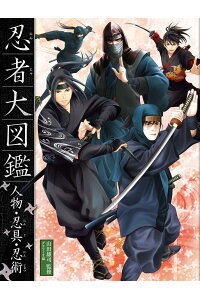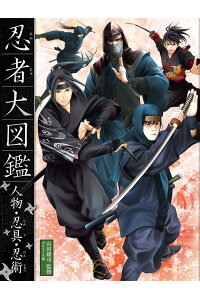山田雄司 監修「忍者大図鑑 人物・忍具・忍術」 金の星社
またまた忍者関連の本の紹介です。何冊あるの?と言うくらい最近は沢山の本が出版されています。今回も監修は三重大学教授の山田先生です。この本は、題名の通り図鑑ですので、ほとんどがイラストになっています。現代風の顔つき、意匠なので、若干リアリティを感じにくいかも知れませんが、忍具などは絵になっているので分かりやすく表現されています。
少し本の内容を紹介します。最初に忍者のなりたちについて説明があります。飛鳥時代(7世紀ごろ)に日本最古の忍者「志能便(しのび)」あらわれる。奈良時代~平安時代(8~12世紀ごろ)には、忍者衆の源流が発生。伊賀の服部氏、甲賀の望月氏などの有力な集団も、この時代に登場したそうです。鎌倉時代(13世紀ごろ)に「悪党」の台頭し、その中から、“忍び”上手とよばれる者たちがあらわれました。南北朝時代(14世紀ごろ)に「忍び」の登場し、軍記物語「太平記」に、「逸物の忍び」が夜中に京都の石清水八幡宮に侵入し、火を放ったことがしるされていて、これが、歴史上ではじめて「忍び」が登場した記述であります。そして、戦国時代(室町時代後期)~安土・桃山時代(1467年~1602年)に 「忍者」の全盛期を迎えました。
図解で分かりやすいなと思ったのは、火器の説明です。焙烙という素焼きの陶器に火薬をつめてつくる手榴弾のような武器である炮烙火矢(ほうろくひや)。矢の先端の容器に火薬がつめてあり、導火線に火をつけて弓ではなつ大国火矢(おおくにひや)。竹筒のなかに鉄粉と火薬をつめたもの。敵のあつい火の粉をあびせかける取火方など、見たことも聞いたこともないものですから、図解がないと全くイメージできません。
跳躍術の説明では、「並の忍者でも、幅跳びで5メートル、高跳びで3メートルをジャンプし、15メートの高さから飛び降りた」そうです。その修行が、成長の早い植物「麻」の上を毎日飛越えて、毎日少しずつ掘り下げた穴の中からジャンプで脱出したりしていたとのことです。幅跳び5メートルは可能かと思いますが、高跳び3メートルは、おそらく何かを踏み台にして飛んだのかなと思います。高さ3メートルの壁も手の先が届けば、つかんで登れるでしょうから。また、15メートルの高さから飛び下りるというのは、物理の自由落下で計算すると時速60キロで着地のはずです。地面が土で、草があればショックも和らげられるでしょうが、コンクリートや石では、骨折は免れないかも知れません。ただし、同じ様な高さの清水寺の舞台から飛び降りても、8割は生きていたらしいですから、何か着地のテクニックがあるのかも知れません。(完)

価格:4,180円
(2021/5/28 12:28時点)
感想(0件)
“The Big Book of Ninja: Persons, Ninja Tools, and Ninjutsu” supervised by Yuji Yamada, Kinsei-sha Co.
Here we go again with another ninja-related book. How many books are there? There are so many books published these days. This time, too, the book is supervised by Dr. Yamada, a professor at Mie University. The book is a pictorial book, as the title suggests, and most of the illustrations are of modern faces and designs, so it may be a little difficult to feel a sense of reality.
Here is a little about the book. First, there is an explanation of the origin of the ninja. In the Asuka period (around the 7th century), the oldest ninja in Japan, “Shinobi,” appeared. From the Nara to Heian periods (around the 8th to 12th century), the origin of the ninja arose. The Hattori clan of Iga, the Mochizuki clan of Koga, and other powerful groups also appeared during this period. The Kamakura period (around the 13th century) saw the rise of “rogues,” and from among them emerged those who were called “skilled ninja. In the Taiheiki, a military chronicle, it is written that “Itsuzumo no ninja” invaded Iwashimizu Hachiman Shrine in Kyoto in the middle of the night and set it on fire, which is the first mention of “ninja” in history. The period from the Sengoku Period (late Muromachi Period) to the Azuchi-Momoyama Period (1467-1602) marked the heyday of the “ninja”.
What I thought was clear in the illustration was the explanation of firearms. The gunpowder is poured into an unglazed pottery called a roasting pan, which is a grenade-like weapon called a gunlock hiya. The daikoku hiya is an arrow with gunpowder in a container at the end of the arrow, and is fired with a bow when the fuse is lit. A bamboo tube filled with iron powder and gunpowder. Without an illustration, it would be difficult to visualize the firefighting method, as I had never seen or heard of such a method of spraying sparks of fire from an enemy’s fire.
According to the description of the leaping technique, “even an ordinary ninja could jump 5 meters in the broad jump and 3 meters in the high jump, and jump down from a height of 15 meters. The practice involved jumping over hemp, a fast-growing plant, every day, and jumping out of holes that were dug a little deeper every day. I think a 5-meter broad jump is possible, but a 3-meter high jump was probably done using something as a springboard. I think he could reach the 3-meter-high wall with the tip of his hand, and if he could reach it, he would be able to grab it and climb it. Also, jumping down from a height of 15 meters means that he would have landed at a speed of 60 kilometers per hour, according to the free-fall calculation of physics. If the ground is soil and grass, the shock would be lessened, but if the ground is concrete or stone, the jumper might not be able to avoid fracturing his bones. However, it is said that 80% of the people who jumped from the stage of Kiyomizu-dera Temple at a similar height survived, so there may be some kind of landing technique. (END)
“The Big Book of Ninja : Persons, Ninja Tools, and Ninjutsu” supervisé par Yuji Yamada, Kinsei-sha Co.
C’est reparti pour un autre livre sur les ninjas. Combien de livres y a-t-il ? Il y a tellement de livres publiés de nos jours. Cette fois encore, le livre est supervisé par le Dr Yamada, professeur à l’université de Mie. Le livre est un livre d’images, comme le titre le suggère, et la plupart des illustrations sont des visages et des dessins modernes, il peut donc être un peu difficile de ressentir un sentiment de réalité.
Voici quelques informations sur ce livre. Tout d’abord, il y a une explication de l’origine des ninjas. Au cours de la période Asuka (environ le 7e siècle), le plus ancien ninja du Japon, le “Shinobi”, est apparu. De la période Nara à Heian (environ du 8ème au 12ème siècle), l’origine des ninja est apparue. Le clan Hattori d’Iga, le clan Mochizuki de Koga et d’autres groupes puissants apparaissent également à cette époque. La période Kamakura (autour du 13e siècle) a vu l’apparition de “voleurs”, et parmi eux sont apparus ceux que l’on appelle les “ninja qualifiés”. Dans le Taiheiki, une chronique militaire, il est écrit que “Itsuzumo no ninja” a envahi le sanctuaire Iwashimizu Hachiman à Kyoto au milieu de la nuit et l’a incendié, ce qui constitue la première mention de “ninja” dans l’histoire. La période allant de la période Sengoku (fin de la période Muromachi) à la période Azuchi-Momoyama (1467-1602) a marqué l’apogée des “ninja”.
Ce que je trouvais clair dans l’illustration, c’était l’explication des armes à feu. La poudre à canon est versée dans une poterie non émaillée appelée rôtissoire, qui constitue une arme ressemblant à une grenade appelée gunlock hiya. Le daikoku hiya est une flèche avec de la poudre à canon dans un récipient à l’extrémité de la flèche, et est tiré avec un arc lorsque la mèche est allumée. Un tube de bambou rempli de poudre de fer et de poudre à canon. Sans illustration, il serait difficile de visualiser la méthode de lutte contre les incendies, car je n’avais jamais vu ni entendu parler d’une telle méthode consistant à projeter des étincelles de feu sur le feu d’un ennemi.
D’après la description de la technique de saut, “même un ninja ordinaire pouvait sauter 5 mètres en largeur et 3 mètres en hauteur, et descendre d’une hauteur de 15 mètres. L’entraînement consistait à sauter par-dessus du chanvre, une plante à croissance rapide, tous les jours, et à sauter hors de trous creusés un peu plus profondément chaque jour. Je pense qu’un saut en longueur de 5 mètres est possible, mais un saut en hauteur de 3 mètres était probablement réalisé en utilisant quelque chose comme tremplin. Je pense qu’il pouvait atteindre le mur de 3 mètres avec le bout de sa main, et s’il pouvait l’atteindre, il serait capable de l’attraper et de l’escalader. De plus, sauter d’une hauteur de 15 mètres signifie qu’il aurait atterri à une vitesse de 60 kilomètres par heure, selon le calcul de la chute libre de la physique. Si le sol est constitué de terre et d’herbe, le choc serait atténué, mais si le sol est en béton ou en pierre, le sauteur pourrait ne pas pouvoir éviter de se fracturer les os. Cependant, il est dit que 80 % des personnes qui ont sauté de l’estrade du temple Kiyomizu-dera à une hauteur similaire ont survécu, il existe donc peut-être une sorte de technique d’atterrissage. (FIN)
